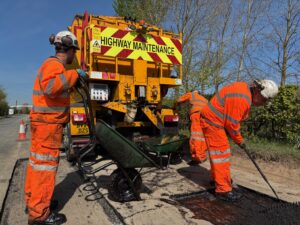Suffolk County Council has launched a pothole prevention programme to target areas of Suffolk’s road network that could worsen when the winter weather hits.
Teams with additional resources and the latest technology have already started visiting and treating locations susceptible to deterioration or where there are smaller defects that could grow as the colder and wetter weather strikes.
Building on the success of earlier trials with the Roadmender Elastomac and Dragon Patcher machines, teams will be deployed across Suffolk to use this equipment in addition to our usual Safety Defect Service that deals with larger defects as they occur.
Councillor Paul West, Suffolk County Council’s cabinet member for Ipswich, operational highways and flooding, said: “Cold and wet weather often wreaks havoc with our roads, which is why we have taken proactive steps and developed a targeted campaign to tackle and provide resilience to our road network ahead of this winter.
“This week we launched an additional programme of repairs in areas which pose a higher risk of potholes forming during the winter months. The aim of the programme is to treat areas of Suffolk’s roads earlier with the goal of reducing the number more substantial defects that may cause safety concerns to road users throughout the winter.
“These plans have been carefully worked up over recent months to ensure we can get ahead of pothole repairs between now and December prior to the drop in temperatures, mostly in January, February and March, where the largest number of potholes form. I look forward to sharing progress with residents.”
Highways workers using the Roadmender Elastomac system will target urban roads that are at higher risk of damage to locate cracks and smaller potholes and carry out repairs. Unlike traditional methods, which require potholes to be saw-cut, excavated and asphalt to be compacted on top, Elastomac is a flowable material used to seal the repaired area.
Once applied, this adhesive, flexible material bonds with the existing road surface, preventing water getting in the cracks and extending the road’s lifespan. The process is more sustainable and efficient, reducing material movement and waste by 90%, lowering costs and minimising disruption.
With the Dragon Patcher machines, these clean the surface of the road using compressed air, preparing it for repair with an application of aggregate and hot bitumen material, and will target rural roads.
Fuelled by biodiesel, HVO (hydrotreated vegetable oil), the patcher reduces raw material use, generates zero waste, and has demonstrated significant carbon savings compared to traditional patching techniques.
The locations have been carefully chosen, focusing on areas with a higher risk of potholes forming during winter. Highways teams will be working when weather conditions allow, from 7am to 5pm, moving across the county to treat the more vulnerable areas. Whilst the repairs are underway, traffic will be managed temporarily by staff on site, and there may be waiting times of up to 15 minutes.
Highways authorities up and down the country experience an inevitable rise in potholes during the winter months. Water seeps into cracks in the road surface which freezes, expands then breaks up the road surface. The purpose of this preventative programme is to seal treated areas of Suffolk’s road network to reduce water getting into cracks reduce the overall number of potholes forming.
PIC-.GOV.UK






















